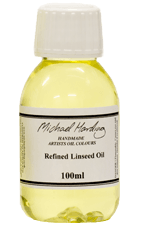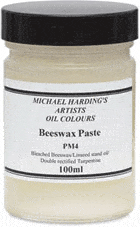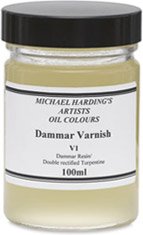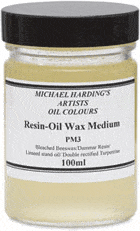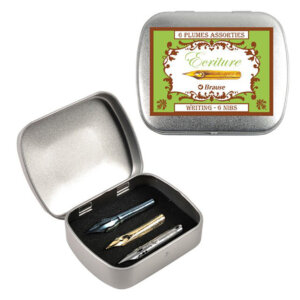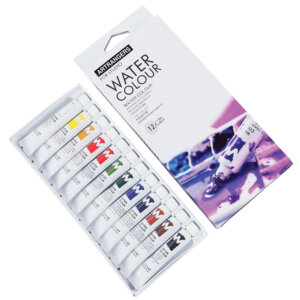Description
Michael Harding Refined Linseed Oil is an alkali refined linseed oil, a pale oil extracted from the seeds of the flax plant. This oil is used in many of Michael Harding’s paints because alkali refined linseed oil produces the strongest paint film during the drying process and ensures the longevity of each painting.
When mixed with oil paint, refined linseed oil will increase the gloss and transparency of the paint, and will thin the paint so that it flows more easily and does not hold brushmarks. It will also slow the drying time of the paint. Refined linseed oil is also highly suitable for use with dry ground pigments. Please note that production and import is currently restricted, please refer to Langridge Refined Linseed Oil in our separate listing, it is an identical Australian made product, we have included detailed notes and instructions on both products at the bottom of each page.
Please note soft materials which have absorbed linseed oil should be stored in sealed containers, as the oil will oxidise when exposed to the air. This chemical reaction releases so much heat that the rags may spontaneously combust. Make sure the lid of the container is closed securely and store in a cool place. Brushes and tools used with linseed oil should be cleaned with white spirit.
MICHAEL HARDING SAYS OF REFINED LINSEED OIL: “So much has already been written upon Linseed oil I do not aim to repeat but to simply give a broad outline as to the caricature of this remarkable gift from nature. Indeed a gift! Please consider that before the industrial revolution there were no factories producing nice thick viscous resin that could be incorporated with coloured pigments to produce fine artist paint. However on this particular occasion Mother Nature has been incredibly generous in giving us linseed oil. Not only is linseed oil a health supplement it also makes a wonderful drying base for artist paint. It also dries in a timely manner with a strong film. Consider the old fashioned floor covering linoleum obviously also made from linseed, how tough and how kind nature has been! It dries in several days allowing the artist to revisit areas of the painting to adjust to taste the finished appearance of the work. Linseed oil comes from the seeds of the flax plant Linum usitatssimum, some writers claim mans relationship with the plant goes back some 30,000 years to Eastern Europe. It became common to many cultures down through the centuries mainly for its other major use that of making linen and yes that obviously means canvasâÂÂs for artist also. Indeed a very special gift from nature, the name in Latin usitatissimum means most useful. So we artists owe a great deal to this beautiful small plant”.
Today linseed oil or rather flax is grown in many places throughout the world that is both wet and cool. Europe where Michael HardingâÂÂs linseed oil comes from is ideal.
The Drying Process of Linseed
When we use the term drying it is a rather inaccurate way of describing what is actually happening. Drying is a term we normally use to describe evaporation such as the case with watercolours or anything for that matter; once the liquid water has departed we are left with a solid soluble mass. Linseed oil is different I sometimes feel the term âÂÂcureâ would be more appropriate though even then from a chemists point of view this would not be quite correct either. When we describe the process of oil paint becoming solid it is by a process of polymerisation in laymenâÂÂs terms the term drying not surprisingly being used. The polymerisation is the process by which the linseed combines with oxygen in air to form a solid. Other factors such as the chemistry of pigments can affect the speed such as the speeding up of the process with pigments that are metal based such as earth colours containing iron. There also is a more complex relationship involving other natural elements within the oil such as iodine, which also play a large roll.
Speed of drying can be influenced by a number of things, the more light and warmth playing a fundamental part, we all remember from school chemistry that warmth speeds all chemical reaction and again not surprisingly this is the case with linseed. Presence of metallic elements as stated before is a strong influencing factor.
Often oil paint manufacturers include artificial drying agents or siccatives, as they are more professionally known, these can be harmful to the paint structure itself and cause lots of problems from embrittlement to flaking to wrinkling. This is a practice we do not engage in with the exception of two products, our Paint Medium No 2 (PM 2) a glaze medium, and our titanium white No 3. The titanium no 3 was added to the range to appease the frustrated artists of London who paint in cold studios and strangely though there is only a minute amount of siccative probably the same amount as within other brands this is a product I light heartedly say I do not want you to buy it as it affects the longevity! I want your paintings to last for at least 500 years and if constructed accordingly and upon a sound support they should have every possibility to do so.
When the paint film containing linseed takes up this very minor amount of oxygen from the air it means that the actual paint becomes slightly larger and as it expands it causes problems like wrinkling. As an analogy imagine coming home to find your carpets had grown and increased in surface area, not surprisingly the carpet would appear in rolls or wrinkles. It has a similar visual affect with the surface of your paint as it slowly expands. If the body of the paint is either low in oil content for example lead or cadmium based pigments the texture of the paint is such that it will resist the tendency to wrinkle unless unnecessary amounts of linseed have been added.
To get the best clarity from linseed oil paints its always wise the let the painting dry in a good light, ideally in a window with good strong day light even direct sunlight for a few days will do no harm. The reason for this advice is if you allow a painting to dry in a bad light it will render the painting to have a dull yellow cast over it, this yellow affect will clear up once the painting is back in normal lit conditions however it will never be as bright or crisp as painting dry in well lit environments. Of course artist often think to protect the work from the ravages of all from children to pets and dust is wise placing the painting a painting in a dark place but this can be very counterproductive.
Cold Pressed versus Refined Linseed Oil
We often get asked if our linseed oil cold pressed or refined the answer is it is both!
Books often state cold pressed linseed oil (CPLO) is the best for oil paint making this is not quite true, when the first pressing of flax seeds takes place the oil that is extracted is quite dark and contains much mucilage and other impurities which tend to darken with age. Various writers explain how to refine further CPLO to remove these; the writings of Tadd Spurgen explain in detail how to do this. If I was to make any white oil paint using a CPLO it might not surprise artists that since using a darker oil the resulting colour of the white would be darker. Particular in the case of titanium paints since oil always likes to come to the surface of the paint film and you then get what appears to be a glaze of the natural colour of the oil. Also not surprisingly a lighter clearer oil will not exhibit such a pronounced colour shift. Its rather obvious if you think about it! Our linseed oil has first be cold pressed and then it is further refined giving it a very light colour. I was recently in the studio of my good friend Leo Mancini Heresko a Boston based artist and ex Florence Academy Professor, Leo was extolling the virtues of he most recent experiments involving the refinement of CPLO.
He had acquired a nice rich looking CPLO he had then combined it with an equal part of water and an amount of sand, he had shaken it and drained it according to various directions and achieved a very pleasing shade of pale linseed. Out of interest he and I decided to make a further experiment using my linseed we use for our entire paint making. We shook it up with water for a few minutes and left it to stand a few hours. I was excited about perhaps being able to offer artist an addition to our mediums, to our surprise as the hours past there was no separation of mucilage of any sought. Yes the sand and water sunk to the bottom of our container with the oil not surprisingly on top however were we had expected to see a nice waxy deposit of impurities, there was none! The good news our oil was already pure enough with no need of further refinement, the bad news there was to be no new oil medium added to the rangeâ¦. For those of you who would like to use CPLO I would urge you to conduct this refinement yourselves or simply use our linseed oil which is now available in various sizes.”

